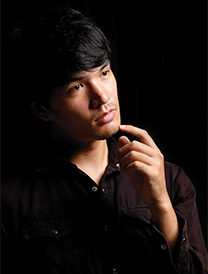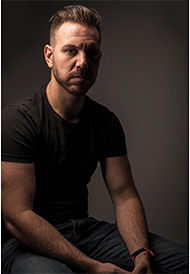
Why do we take portraits? The question may appear a bit silly to some but the basic reason to take portraits is to create a satisfactory likeness of the person being photographed , to convey his/her character and at the same time, be artistically pleasing.
Rohinton Mehta
To be a good portraitist, the photographer should be able to read and bring out the character of the sitter and should have good control over the effects of light and shade – after all, photography is an interplay between light and the shade/ shadows it casts. By merely looking at a subject, the photographer should be able to instantly decide what features of the subject need to be highlighted and what features should be subdued. At the same time, he needs to be fairly conversant with the tools of his trade – the camera, lighting equipment, posing the model, a fair idea of makeup and hairstyling, using props etc. (I mentioned “fair idea” of make-up and hair styling, because we generally employ the services of a make-up artist/hair stylist).
Before we go ahead, understanding a little human psychology will help. All human beings (and animals too) feel comfortable in the surroundings that they are used to. We feel comfortable when we are amongst the people we know and trust. What happens if you were to pick up a baby who does not know you? You may be a photographer but do you feel comfortable if you notice someone taking your picture with his cell-phone camera as you walk down a street? So, if you, as a photographer, feel uneasy if a stranger were to take your photo, why wouldn’t a model? You may say “Oh, professional models have overcome that problem”, you would still be wrong; professional models too need some time before they feel comfortable with you. To most people, sitting for a portrait can be an uncomfortable experience. In the days of film photography, many portrait photographers used to shoot the first roll without actually putting a film roll in the camera – this was done to give some time to the model to get used to the photographer – and it worked – as long as you were not caught!
Remember, the model’s face will reflect what is in her mind; if she is happy and comfortable, her face will show that. If she is uncomfortable (either with you, your assistants – if there are any, or if the set-up area is unclean and/or disorganised), her face will reflect her feelings.
So, how do we take care that our subject feels comfortable? There are a number of thing that we can do. For example:
1. Keep the shooting area clean and uncluttered.
2. Be cordial to the model and her assistants.
3. Play some soft music which she likes.
4. Don’t scream at your assistants in case they make a mistake (this will definitely have an effect on the model).
5. Talk to the model. This is very important. Ask questions on topics she may be familiar. Make her speak.
6. As a photographer, you must be able to talk on various subjects. If you are photographing a housewife for example, talk about the kitchen, cooking, or about the books she has read/would like to read. If your subject is a cricketer, talk about cricket (and not about the kitchen – unless the cricketer also happens to be a good cook!). If the subject is a doctor of medicine, talk about something related to medical science. In other words, you – the photographer – should be what we generally refer to as a ‘jack-of-all’.
7. Know your subject (portraiture) and be knowledgeable about using your gear. If you fumble with your lights or with your camera, an experienced model will immidiately notice that and may wonder why she allowed herself to be photographed by an amateur. And that will be reflected in her expressions!
8. You may not be a liar; but when photographing humans, a bit of lie will not hurt. Encourage the model (even if she is not posing the way you would like her to). Say things like, “good, lovely, great pose, excellent, wow, you are looking very pretty, amazing, etc. Say these words (not all of them at the same time!) with some feelings in you.
9. At no time should you show your annoyance. If you do, you may as well forget about her posing well for you.
10. The most important – Respect the model at all times and don’t do anything that may unnerve or upset her. For example, don’t keep staring at her vital statistics or look at her in a lecherous manner or say someth ng ungentlemanly. I know that most photographers wouldn’t do that, but it’s here for the record.
What makes a good portrait?
A good portrait or for that matter, any photograph, is the sum-total of of different qualities – Lighting (the most important), framing (composition), posing, choosing the right lens and the right camera angle, technical quality, your individual style and luck (sometimes) all contribute to a great shot. When we talk of tecnical quality, we are referring to the subtle gradations and tonality within the highlights and shadows, the range and smoothness of colours, contrast and tonal density appropriate to the subject.
When talking of portraits, the size of the portrait studio is important. I am talking of the ideal room size, though in reality, we are often forced to work in a make-shift/temporary ‘studio’. There should be sufficient distance between the model and the backdrop; no shadow from the subject should fall on the backdrop. This distance will also tanslate to the backdrop getting out of focus even when the lens is sufficiently stopped-down for the required depth of field.
There should also be sufficient distance between the camera and the subject even when using a fairly long focal length lens. The distance behind the photographer and the back wall is equally imporatnt so that the photographer has enough space to move around and shoot. The room should be wide enough to allow the proper placement of the various lights. Ideally, a portrait studio should be 12’ wide or more x 18’ in length. This would take care even of a group of say, 8 persons.
Photographing the subject at her eye level and using a lens of 80-105mm on a full-frame sensor camera) or about 55/60mm lens on an APS-C model is generally considered the best for portraiture. A wide-angle lens will distort the face (since you will have to go closer to fill the frame) and a very long focal length lens at a close distance could compress the perspective.
Goal and Tools
The ‘goal’ is to idealise our subject – to make him/her look better than he/ she really is. The ‘tools’ in achieving this are our camera, lens, lens angle, pose, lighting and retouching. The most important is the lighting. In this write-up, we shall talk more about the lighting aspect.
Proper lighting can create mood and modelling (properly show the contours of the face). Light areas always stand out while dark areas hide details. With this in mind, we can set up our lighting to highlight the five prominent areas of the face while keeping in shadow the sides of the face and the neck. The five areas to highlight are: the forehead, the bridge of the nose, both the cheeks and the chin. Doing this will create a sort of 3D effect (remember our photograph has only two dimensions – the width and the height. By proper use of light, we can visually create the dimension of depth).
Portrait Lighting Techniques
The following techniques will produce artistic and sellable portraits. It should be borne in mind that these are the basic tecniques to start with; these are not the only methods of creating sellable portraits.
Once you master them, you are free to try any variation thereof.
One question before we start
How many lights do you think we need for a successful portrait? The number will vary depending on whom you ask. Remember, in nature, we have only one light source – the sun (or the moon) – and we still see everything with proper modelling. Though there are good reasons why professional photographers use several lights to light up a portrait, my advice to beginners is to start with only one light. Once you are happy with the results of your one-light portriats, you may use additional lights.
Short Lighting (also known as Narrow Lighting)
Short lighting is a ‘corrective’ lighting for plump or round faces (Please see image overleaf).
In this type of lighting, the Main light – also referred to as the Key light – illuminates the short side of the face. Short side of the face? What’s that, you might ask? To understand that, we must first know how to pose the subject in relation to the camera lens. The subject should never face the camera squarely. As a general rule, make the subject turn her body about 45° to the axis of the lens. Now ask her to turn her upper body towards the lens, while keeping her lower body still in the 45° position to the lens. Now when you look through the camera, you will see more of one side of her face. This is the broad side while the other side, which is partially hidden from the camera’s view, is the short side. In Short lighting, we start by placing the Main light to illuminate the short side of the face. This results in the broad side remaining in shadow and causes the face to look narrower or thinner. That’s why we call it ‘corrective’ lighting.


Placement of the Main light
Place the Main light – which should ideally be a large (diffused) light source (if photographing women/children) or a moderately hard light (for men) – at an angle of approximately 45° to one side of the lens-subject axis, but higher than the subject’s head. There are three points to consider here.
1. While placing the Main light, observe the shadow of the nose, cast by the main light. The shadow must not touch or cross the lip line. If the light is too high, the nose shadow will cross the lip line. If the light is not high enough (if it is placed at the same height as the subject’s face for example), chances are that the noise shadow will go above the nose and this will look horribly wrong. In nature, have you ever seen a shadow of the nose go higher than the nose?
2. When the placement of the main light is correct, you will observe an inverted highlighted triangle form under the eye opposite to the main light. If this trangle is not formed, the light position is wrong and needs to be corrected.
Note: If the nose shadow and the cheek shadow do not touch, the lighting is also referred to as Loop Lighting. If the nose shadow and the cheek shadow, the lighting is referred to as Rembrandt lighting.
3. The main light must cause catchlights in the eyes. Depending on which side the subject is facing, the catchlights should appear at either 11 0’clock or 1 0’clock for Short lighting and Broad lighting
Only after these three conditions are met, should you consider another light.

